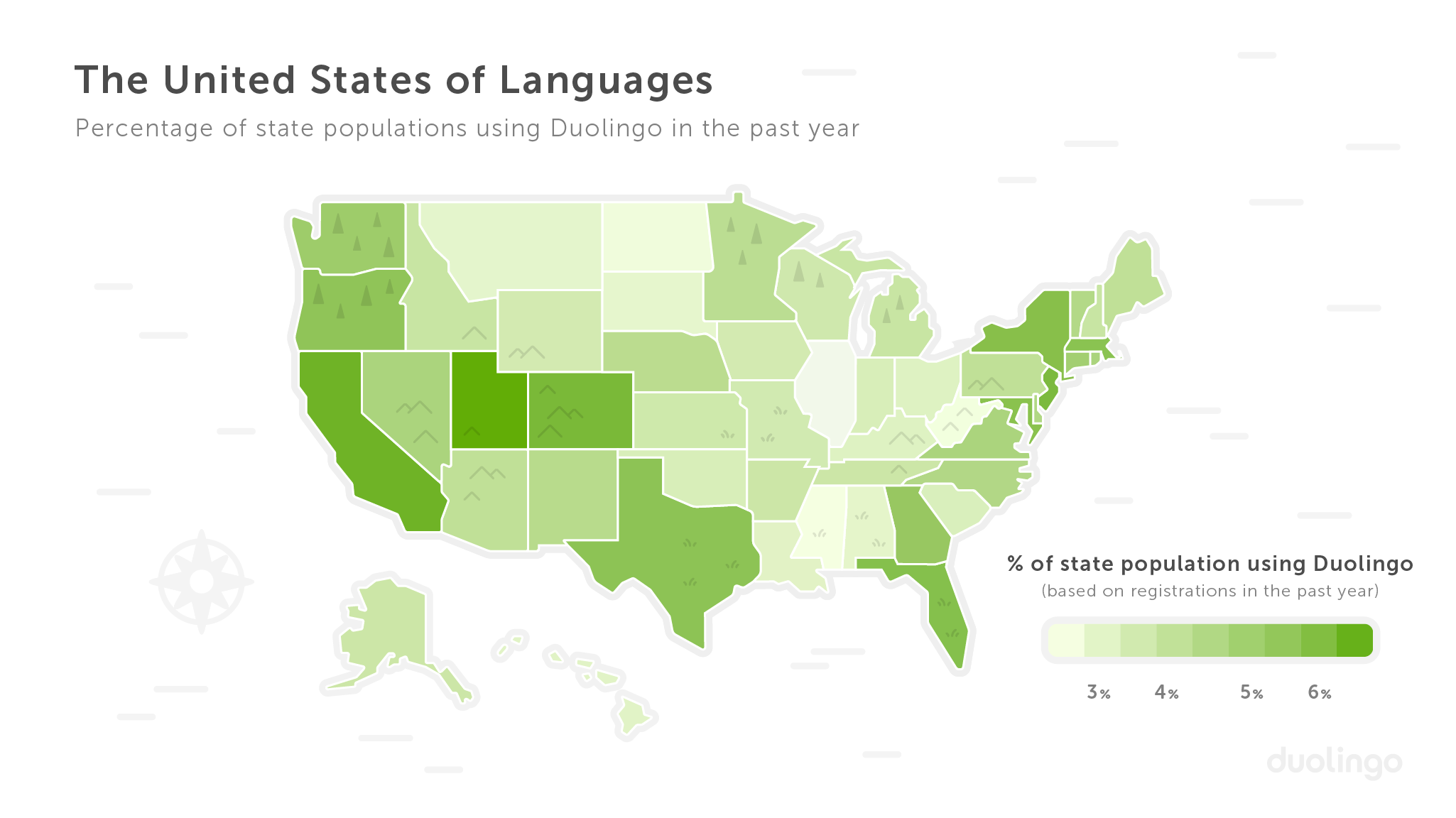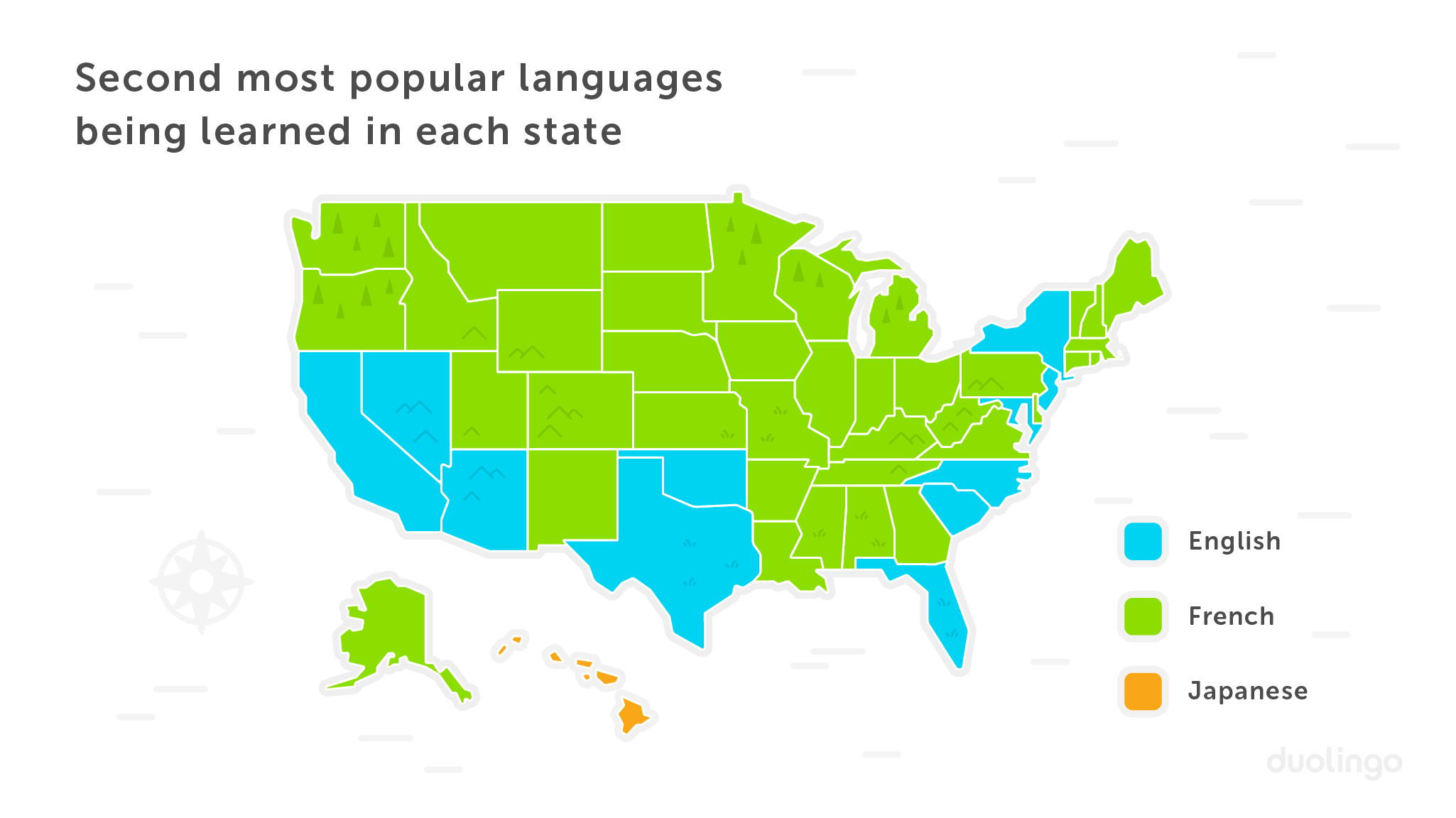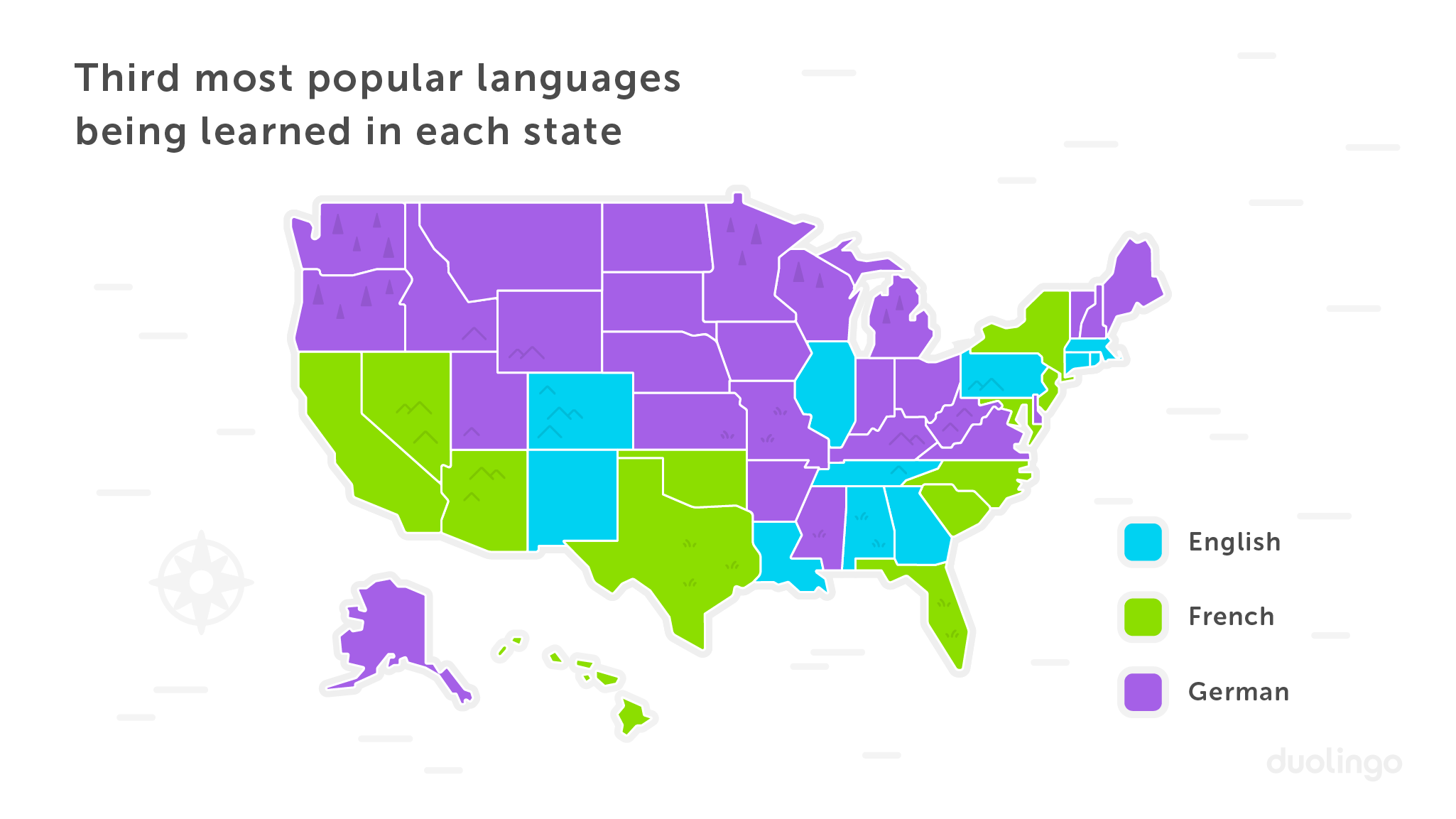Our analysis last year of language-learning patterns around the world yielded some interesting findings. For example, did you know that Swedish is the top language studied on Duolingo in… Sweden? (While initially puzzling, it turns out that the strong influx of immigration to Sweden in recent years is the likely reason for this.)
Given the popularity and interest in our global analysis, we wanted to do something similar for our home country. Duolingo is very international, but the United States is actually our largest country, and home to 57.8 million users. In fact, Duolingo is by far the most popular way to learn languages in the US: there are more people learning languages on Duolingo in the US than there are people learning foreign languages in the entire US public school system.
Even though the US is technically one country, we take interstate and regional language differences pretty seriously. For instance, are you adamant that it’s “pop”, not “soda”? And does your New Yorker friend make fun of your Texan friend for saying “y’all” rather than “you guys”?
Our differences aren’t just limited to minor preoccupations about regional language patterns. In analyzing the language-learning habits of our users in the US, we found interesting variations on states’ and regions’ foreign language preferences, how dedicated users in different states are to making language learning a daily habit, and more.
Before we get into the results, let’s see if you can guess the following. Read on for the answers. (Number 4 will shock you!)
- Which state has the highest proportion of users learning languages with Duolingo?
- In which US region is German being learned by the highest proportion of users? What about Japanese?
- Which state has the highest proportion of Spanish speakers learning English?
- Which is the only state where Russian is one of the top five languages being learned on Duolingo?
- Which state has the highest proportion of people who use the app an average of 120 or more days in a row?
Which states have the highest (and lowest) proportion of language learners?
We were intrigued to find that out of all 50 states, Utah came out on top with the highest proportion of people who started learning languages with Duolingo in the past year. To calculate the proportion, we divided the number of users who registered on Duolingo in the past year in each state by the current population of each state, and got a percentage of 6.78% in Utah – the highest out of every state (see Figure 1).
But why Utah? One hypothesis is that as the state where the Church of Jesus Christ of Latter-day Saints is headquartered, Utah has a high number of people learning languages as they prepare to take international mission trips.

After Utah, the next top states for proportion of language learners are California (6.39%), Colorado (6.1%), New Jersey (5.96%), Florida (5.67%), New York (5.66%), Maryland (5.62%), Massachusetts (5.55%), Texas (5.5%) and Oregon (5.41%).
Now, what about the states with the lowest proportion of language learners? Mississippi came out on the very bottom, with a proportion of just 2.17%. Interestingly, Mississippi also ranks last in terms of States’ access to the Internet. In fact, the correlation coefficient between Internet access and language learners on Duolingo is 0.64, which is quite high. This suggests that a state’s Internet infrastructure plays a significant role in the use of Duolingo by people who live there, which is not surprising.
After Mississippi, other states with the lowest proportion of language learners are West Virginia (2.19%), North Dakota (2.27%), South Dakota (2.59%), Montana (2.67%), Alabama (2.7%), Hawaii (2.76%), Louisiana (2.78%), Kentucky and Ohio (2.87% each), and South Carolina (2.99%).
Which languages are the most popular in each region?
Unsurprisingly, Spanish came out on top as the most popular language being learned in all 50 states by a wide margin, with an average of nearly 45.4% of users learning the language. In most states, French is the second most popular language, with an average of nearly 15.8% of users learning it. And in several states with a high number of Spanish speakers – including California, Arizona, Nevada, Texas, Florida, New Jersey and New York – English from Spanish is the second most popular language being learned, with an average of about 8% of users learning it. Hawaii is the only state where Japanese is the second most popular language being learned (see Figure 2).

Since French dominates as the second most popular language in most states (followed by English from Spanish), we also looked at the third most popular language being learned in each state. This is where the data got more varied and started showing some interesting trends: for instance, German is the third most popular language among many users in the Midwest and northwestern US. And French is the third most popular language in some of the southern and southwestern states where English from Spanish is the second most popular language (see Figure 3).

When it comes to regional language-learning trends, our analysis showed some clear patterns:
-
While Spanish is the most common language being learned in all 50 states, it is especially popular among users in the South: Mississippi, Arkansas, Kentucky, and Louisiana have the highest proportions of Spanish language learners. In Mississippi, 55.4% of Duolingo users are learning Spanish, followed by 54.6% in Arkansas, 53.4% in Kentucky, and 52% in Louisiana.
-
In contrast, the states with the highest proportions of users learning English from Spanish are more spread out, with the top states being Florida (24.7% of users), New Jersey (22.9%), Nevada (22%) and Texas (18.5%).
-
Ooh la la and mamma mia: French and Italian are both especially popular languages in the Northeast. French is most popular in Vermont (27% of users), Maine (26.8%), and New Hampshire (22.1%). Louisiana is a close fourth for French, at 18.3%. Italian is most popular in Rhode Island (9.9%), Connecticut (9.5%), and New York (8.8%), followed by New Jersey and Vermont with 8.3% each.
-
German happens to be most popular in the Northwestern US, with the top states being South Dakota (13.6%), North Dakota (13.4%), Alaska (12.6%), and Montana (12.3%).
-
Japanese is most popular among users in the western US, likely given its proximity to Japan and since many of the states have relatively large Japanese or Japanese-American populations. The top states where Japanese is being learned are Hawaii (17.4%), Washington (7.9%), Oregon (7.3%), and Alaska (6.7%).
-
The only state where Russian is one of the top five languages being learned is Alaska, with 5.5% of users there learning the language. This makes sense, since some Alaskan residents claim they can actually see Russia from their homes.
Which states have the most (and least) dedicated language learners?
One of the primary features Duolingo offers is the ability to maintain a streak. The concept is simple: if you meet your daily goal on Duolingo for 2 days in a row, you have a 2-day streak. Miss a day? It goes back down to 0. The idea of keeping a streak is incredibly motivating for users, and we set out to identify in which states users are the most diligent about maintaining their streaks.
To find the data, we looked at the average proportion of daily active users over the past year in each state that have a streak in ranges that are short (3-29 days), medium (30-119 days), and long (120 or more days) (see Figure 4).

Interestingly, some of the states with the lowest number of language learners – like North Dakota and Montana – came out on top in making language learning a daily habit: North Dakota has the highest average proportion of users who have been successful in maintaining their Duolingo streaks for 120 or more days, and Montana has the highest average proportion of users with a streak of 3-29 days. New Hampshire has the highest average proportion of users with a medium streak of 30-119 days.
Conversely, some of the states that have the highest number of language learners – including Florida, New Jersey, and Texas – aren’t so great at making language-learning a daily habit. Florida came out on the very bottom for the average proportion of users with streaks of both 30-119 days and 120 or more days, and New Jersey came out on the bottom for streaks of 3-29 days.
Here, we see an interesting pattern where users living in more densely populated states with major metropolitan areas are not as diligent about maintaining streaks on Duolingo, while users in less densely populated states are the most dedicated to maintaining their streaks.
Just like the neverending soda vs. pop debate, the preferences for which languages we learn (and how dedicated we are to learning them) can say a lot about regional and interstate differences in the US. Are you living in the US and learning a language? If so, we’d love to hear about whether any of our findings apply to you!
* Special thanks to Erin Gustafson, data scientist at Duolingo, for her help in gathering several of the data points used throughout this post, and to Sean Dockery, designer at Duolingo, for creating the graphics throughout the post.